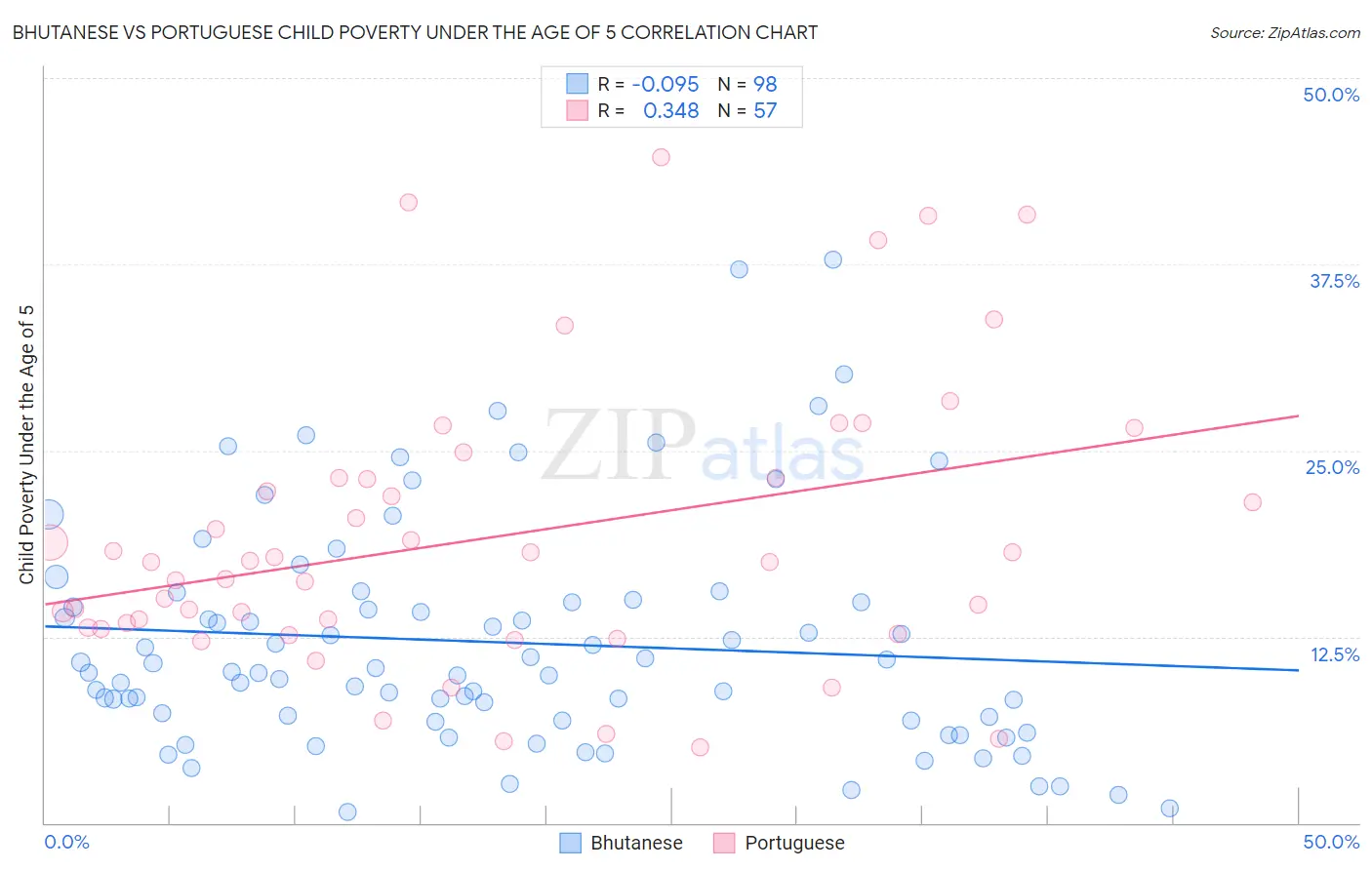Bhutanese vs Portuguese Child Poverty Under the Age of 5
COMPARE
Bhutanese
Portuguese
Child Poverty Under the Age of 5
Child Poverty Under the Age of 5 Comparison
Bhutanese
Portuguese
13.4%
CHILD POVERTY UNDER THE AGE OF 5
100.0/ 100
METRIC RATING
13th/ 347
METRIC RANK
16.5%
CHILD POVERTY UNDER THE AGE OF 5
83.0/ 100
METRIC RATING
142nd/ 347
METRIC RANK
Bhutanese vs Portuguese Child Poverty Under the Age of 5 Correlation Chart
The statistical analysis conducted on geographies consisting of 434,270,600 people shows a slight negative correlation between the proportion of Bhutanese and poverty level among children under the age of 5 in the United States with a correlation coefficient (R) of -0.095 and weighted average of 13.4%. Similarly, the statistical analysis conducted on geographies consisting of 426,968,187 people shows a mild positive correlation between the proportion of Portuguese and poverty level among children under the age of 5 in the United States with a correlation coefficient (R) of 0.348 and weighted average of 16.5%, a difference of 23.7%.

Child Poverty Under the Age of 5 Correlation Summary
| Measurement | Bhutanese | Portuguese |
| Minimum | 0.77% | 5.1% |
| Maximum | 37.8% | 44.7% |
| Range | 37.1% | 39.6% |
| Mean | 12.1% | 19.2% |
| Median | 10.1% | 17.5% |
| Interquartile 25% (IQ1) | 6.9% | 13.0% |
| Interquartile 75% (IQ3) | 14.8% | 23.2% |
| Interquartile Range (IQR) | 7.9% | 10.1% |
| Standard Deviation (Sample) | 7.7% | 9.5% |
| Standard Deviation (Population) | 7.6% | 9.4% |
Similar Demographics by Child Poverty Under the Age of 5
Demographics Similar to Bhutanese by Child Poverty Under the Age of 5
In terms of child poverty under the age of 5, the demographic groups most similar to Bhutanese are Okinawan (13.4%, a difference of 0.65%), Indian (Asian) (13.4%, a difference of 0.70%), Immigrants from South Central Asia (13.3%, a difference of 0.75%), Immigrants from Korea (13.2%, a difference of 0.86%), and Burmese (13.2%, a difference of 0.96%).
| Demographics | Rating | Rank | Child Poverty Under the Age of 5 |
| Immigrants | Singapore | 100.0 /100 | #6 | Exceptional 12.9% |
| Chinese | 100.0 /100 | #7 | Exceptional 13.1% |
| Iranians | 100.0 /100 | #8 | Exceptional 13.1% |
| Immigrants | Iran | 100.0 /100 | #9 | Exceptional 13.1% |
| Burmese | 100.0 /100 | #10 | Exceptional 13.2% |
| Immigrants | Korea | 100.0 /100 | #11 | Exceptional 13.2% |
| Immigrants | South Central Asia | 100.0 /100 | #12 | Exceptional 13.3% |
| Bhutanese | 100.0 /100 | #13 | Exceptional 13.4% |
| Okinawans | 100.0 /100 | #14 | Exceptional 13.4% |
| Indians (Asian) | 100.0 /100 | #15 | Exceptional 13.4% |
| Immigrants | Eastern Asia | 100.0 /100 | #16 | Exceptional 13.5% |
| Assyrians/Chaldeans/Syriacs | 100.0 /100 | #17 | Exceptional 13.6% |
| Immigrants | China | 100.0 /100 | #18 | Exceptional 13.6% |
| Immigrants | Ireland | 100.0 /100 | #19 | Exceptional 13.7% |
| Immigrants | Japan | 100.0 /100 | #20 | Exceptional 13.8% |
Demographics Similar to Portuguese by Child Poverty Under the Age of 5
In terms of child poverty under the age of 5, the demographic groups most similar to Portuguese are Samoan (16.5%, a difference of 0.010%), Immigrants from Western Europe (16.5%, a difference of 0.040%), Ethiopian (16.5%, a difference of 0.070%), Immigrants from Ethiopia (16.6%, a difference of 0.18%), and Israeli (16.6%, a difference of 0.19%).
| Demographics | Rating | Rank | Child Poverty Under the Age of 5 |
| Brazilians | 87.8 /100 | #135 | Excellent 16.4% |
| Immigrants | Northern Africa | 87.5 /100 | #136 | Excellent 16.4% |
| Immigrants | Chile | 85.3 /100 | #137 | Excellent 16.4% |
| Germans | 84.8 /100 | #138 | Excellent 16.5% |
| Immigrants | Hungary | 84.5 /100 | #139 | Excellent 16.5% |
| Guamanians/Chamorros | 84.2 /100 | #140 | Excellent 16.5% |
| Immigrants | Western Europe | 83.3 /100 | #141 | Excellent 16.5% |
| Portuguese | 83.0 /100 | #142 | Excellent 16.5% |
| Samoans | 83.0 /100 | #143 | Excellent 16.5% |
| Ethiopians | 82.7 /100 | #144 | Excellent 16.5% |
| Immigrants | Ethiopia | 82.1 /100 | #145 | Excellent 16.6% |
| Israelis | 82.0 /100 | #146 | Excellent 16.6% |
| Immigrants | Nepal | 80.3 /100 | #147 | Excellent 16.6% |
| Syrians | 79.1 /100 | #148 | Good 16.6% |
| New Zealanders | 78.7 /100 | #149 | Good 16.6% |